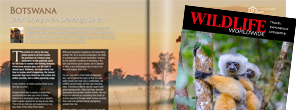Gearing up for Wildlife Photography (Part 2)

In Part 1 we went over at the general essentials for wildlife photography on tour, looking at some of the features you may want from your cameras and lenses. In Part 2 we are looking at some of the key accessories to help you out when capturing images on location.
Camera bag
We are starting with a bag because protecting your investment is important, especially when travelling. Camera bags are a great way of keeping things organised and safe, but making sure you get the right one can be tricky.
 As you’ll likely be flying, be sure to go for something that is carry on compatible, because you don’t want your expensive cameras and lenses going in the hold! Personally when I headed out to Canada, I took my Lowe Pro Trekker, the largest airline compatible bag I can carry that fits in the overhead bin. This had everything I needed for photographing landscapes and bears, as well as my laptop and chargers, all in a single bag. Of course you’ll want a backpack designed for comfort when carrying it in the wild, so be sure to try on a few for size, and to check they carry what you need.
As you’ll likely be flying, be sure to go for something that is carry on compatible, because you don’t want your expensive cameras and lenses going in the hold! Personally when I headed out to Canada, I took my Lowe Pro Trekker, the largest airline compatible bag I can carry that fits in the overhead bin. This had everything I needed for photographing landscapes and bears, as well as my laptop and chargers, all in a single bag. Of course you’ll want a backpack designed for comfort when carrying it in the wild, so be sure to try on a few for size, and to check they carry what you need.
Tripod
The photographer’s best friend, a tripod is a very handy support to have with you, especially if you are working with longer focal lengths or shooting landscapes with slow shutter speeds. Look for one that can go low to the ground and that has a decent head to support your camera and lens combinations. If you are doing a mix of landscapes and wildlife a ball head can be great, but if long telephotos are your sole focus, a fluid or gimbal might be better. When packing, you’ll have to put it in the hold, but be sure to wrap it in clothing to protect it from bumps and knocks from baggage handlers. If weight is going to be an issue, a travel model built from carbon fibre is a great option, but these are on the more expensive side than the larger aluminium options.

Bean bag
 If you are working from a car or safari vehicle, a bean bag is a great option. Picked up cheaply, they can be filled on location to reduce weight when flying, and are excellent for supporting a long lens. I used mine from our hire car when driving through Banff and Jasper national parks, making use of the car as a moving hide with the windows down
If you are working from a car or safari vehicle, a bean bag is a great option. Picked up cheaply, they can be filled on location to reduce weight when flying, and are excellent for supporting a long lens. I used mine from our hire car when driving through Banff and Jasper national parks, making use of the car as a moving hide with the windows down
Cleaning kit
Keeping things clean is important, and cameras can easily malfunction if not kept in good repair. Cheap and easy to get hold of, an essential is a rocket blower. They have a no-return valve to help remove dust from your camera with short sharp bursts of air. Additionally a wet clean kit for the sensor is a good idea, as if you are anywhere that is especially dirty you may soon find you have sensor marks that need cleaning. Only do this back at the lodge or hotel to avoid contamination, and remember to take the fluid out of the suitcase when passing through airport security!
Filters
Filters are often thought to be the domain of the landscape photographer, but they can be very useful for wildlife images too, in particular the polariser. Helping to cut down on reflections and remove glare it is a valuable tool, especially when shooting around water. If you are taking time to go whale watching or hunt down grizzlies in the streams and rivers, this filter can really help to make the most of images, saturating colours and reducing glare.
Travel adaptor
An obvious one for anyone travelling but also think about packing a power strip or extension cord. The additional plug sockets allow you to easily charge multiple devices and mean you wont take up every plug at the accommodation with your various charging and power needs!

Back up solution
For longer trips away, certainly think about bringing along an extra back up for all of your images. With portable hard drives now available at such excellent prices there really is no reason not to have one. A laptop too can be a fantastic addition, allowing you to manage and back up in the field, as well as making sure you are getting the images you are after. On the long plane journey home you can even get cracking with the editing!
So that covers some of the essentials and accessories for gearing up for wildlife photography on your next big adventure. Be sure to invest and get any new gear well in advance of your departure to ensure you have time to get used to it beforehand. If you have any questions about how far away your subjects might be or any particular info about a trip, hit the Wildlife Worldwide team up and they will be more than happy to help.
Catch up on the first instalment of Tom's useful photography gear suggestions for your next Wildlife Photography holiday.








